Ohkay Owingeh Pastel Drawing of Katsina Dancing by Than Ts'áy Tas - C3417
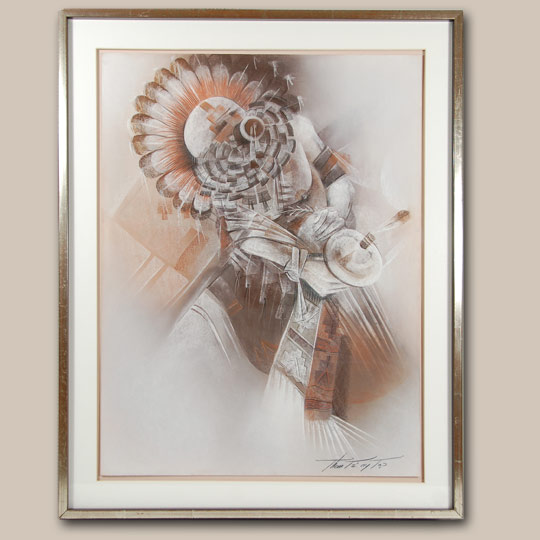 Tommy Edward Montoya (1952-2009) Than Ts'áy Tas pastel drawings of traditional pueblo rites represent the blending of old and new that characterizes the work of young Native American artists. Authenticity is not something he studied; it is something he lived. As an active participant in pueblo ritual life, his works were created from memory. Montoya's dancers are not frozen in shape or time. They are, instead, the artist's personal expression of the color and motion of the moment. He liked to push his figures to the edges of the canvas or art board. That produced the feeling that they were being contained within borders and made them more dynamic and energetic. He was an extraordinary artist who created an extraordinary drawing in this instance.
Tommy Edward Montoya (1952-2009) Than Ts'áy Tas pastel drawings of traditional pueblo rites represent the blending of old and new that characterizes the work of young Native American artists. Authenticity is not something he studied; it is something he lived. As an active participant in pueblo ritual life, his works were created from memory. Montoya's dancers are not frozen in shape or time. They are, instead, the artist's personal expression of the color and motion of the moment. He liked to push his figures to the edges of the canvas or art board. That produced the feeling that they were being contained within borders and made them more dynamic and energetic. He was an extraordinary artist who created an extraordinary drawing in this instance.
Original Painting of Hopi Pueblo Corn Katsina by Richard (Dick) Pentewa - C3653D
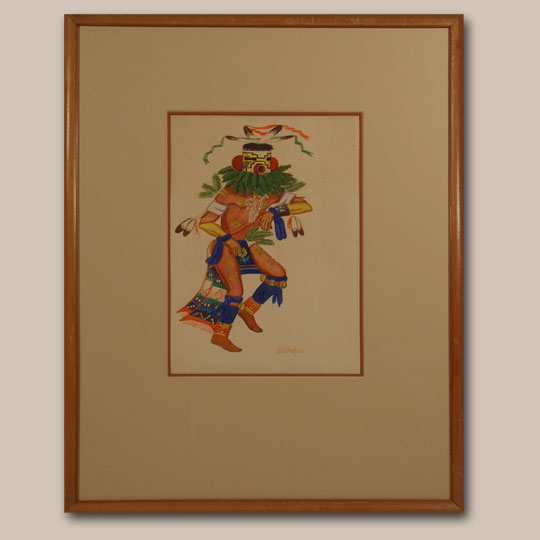 Richard Sitko Pentewa was one of eleven children of the famous katsina doll carver, Otto Pentewa. He was born and raised at Kykotsmovi watching his father carve and paint. While mostly known as a carver, the younger Pentewa was also a very talented painter.
Richard Sitko Pentewa was one of eleven children of the famous katsina doll carver, Otto Pentewa. He was born and raised at Kykotsmovi watching his father carve and paint. While mostly known as a carver, the younger Pentewa was also a very talented painter.
In this watercolor, a Corn Katsina is depicted in fine detail. There is a sense of movement as the beautiful dance sash flutters behind the dancer. The pumpkin flower, the hallmark signature of his father, Otto Pentewa, as well as the Hopi name of the younger Pentewa, is painted on the loincloth of the katsina.
Historic Polychrome Zia Pueblo Olla with Native Repair - C3753.04
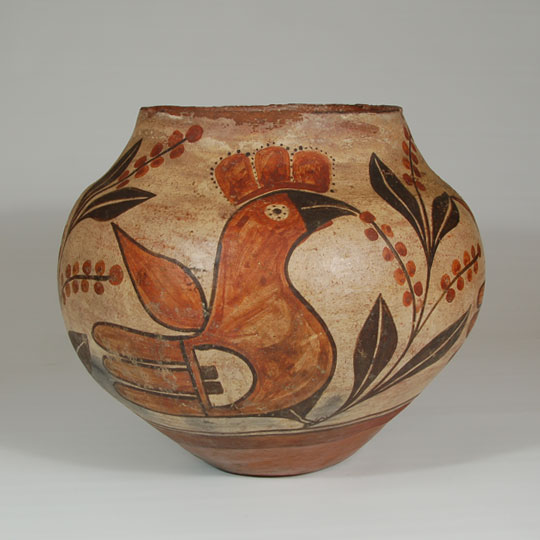 This is a very traditional 19th century Zia Pueblo polychrome olla with a very bold design. The 3 birds are bigger than life and command one's attention. The crowns on their heads add an importance to their character. They exude a regal appearance, as if to say "who is more important than I?"
This is a very traditional 19th century Zia Pueblo polychrome olla with a very bold design. The 3 birds are bigger than life and command one's attention. The crowns on their heads add an importance to their character. They exude a regal appearance, as if to say "who is more important than I?"
As with all Zia jars, this jar incorporates techniques used for six centuries-specifically the use of crushed basaltic lava as temper. The use of the dark brown and orange mineral paints on the white slip offers a visually pleasing contrast. The wide red band underneath the design area is indicative of late 19th and early 20th century pieces.
Original Painting “Navajo Girls Racing Their Ponies” by Harrison Begay - C3653B
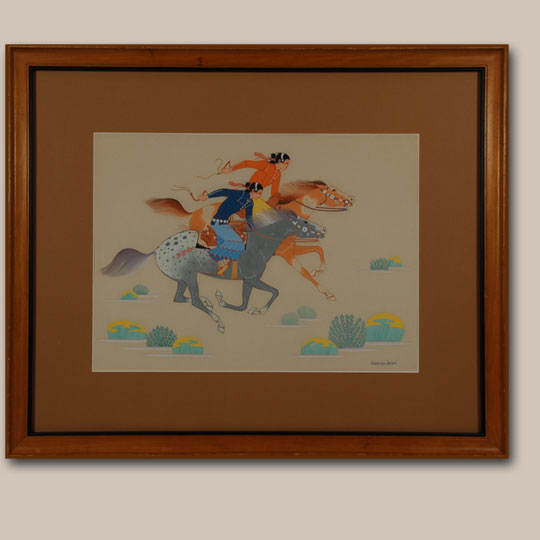 Harrison Begay was a master at capturing the beauty and harmony of everyday Navajo life. In this painting of two young women racing their ponies, Begay has included details that are unique to the Navajo way. The two girls are dressed in traditional woman's fashion, which includes a pleated velvet skirt with a matching top decorated with silver buttons and with a concha belt. On their feet, they have knee high wrapped moccasins. Their hair is held back in the traditional bun or tsee yel. They are wearing turquoise jah clah (ear strings) and silver and turquoise bracelets.
Harrison Begay was a master at capturing the beauty and harmony of everyday Navajo life. In this painting of two young women racing their ponies, Begay has included details that are unique to the Navajo way. The two girls are dressed in traditional woman's fashion, which includes a pleated velvet skirt with a matching top decorated with silver buttons and with a concha belt. On their feet, they have knee high wrapped moccasins. Their hair is held back in the traditional bun or tsee yel. They are wearing turquoise jah clah (ear strings) and silver and turquoise bracelets.
Historic Hopi Pueblo Polychrome Jar with Zuni and Hopi Designs - C3654C
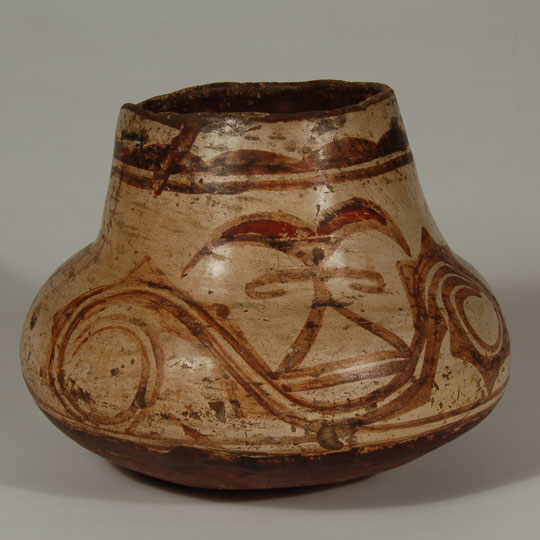 There was a period in the late 1700s and early 1800s when many Hopi left the mesas and migrated to their nearest pueblo neighbor-Zuni Pueblo. This migration was the result of drought, disease, crop failure and other disasters. Many of them stayed at Zuni for 20 or more years and it was during that time that the women were exposed to designs on Zuni pottery. When they returned to their home land, they brought with them the memories of those pottery designs.
There was a period in the late 1700s and early 1800s when many Hopi left the mesas and migrated to their nearest pueblo neighbor-Zuni Pueblo. This migration was the result of drought, disease, crop failure and other disasters. Many of them stayed at Zuni for 20 or more years and it was during that time that the women were exposed to designs on Zuni pottery. When they returned to their home land, they brought with them the memories of those pottery designs.
The Hopi potters were very creative and talented artists so it was not in their interest to copy Zuni pottery designs but to use those designs they saw and experiment with expanding them to enhance their pottery. In the period 1820 to 1860, we see many Hopi pottery vessels with Zuni-inspired designs.
Historic San Ildefonso Pueblo Polychrome Olla by Martina Vigil and Florentino Montoya - 22964
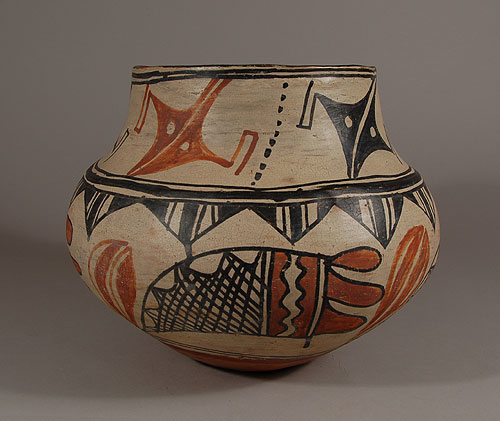 San Ildefonso Polychrome typology gradually replaced its predecessor Powhoge Polychrome typology around the 1890s. There were several changes occurring during this transformation-red paint for designs was revived, vessel shape changed, and black rims replaced red ones. It was also during this time, that potter's names began to be associated with their work.
San Ildefonso Polychrome typology gradually replaced its predecessor Powhoge Polychrome typology around the 1890s. There were several changes occurring during this transformation-red paint for designs was revived, vessel shape changed, and black rims replaced red ones. It was also during this time, that potter's names began to be associated with their work.
As Jonathan Batkin has well documented, there were several outstanding potters at San Ildefonso during the 1890s whose work can fairly accurately be associated with their names. Following publication of Batkin's studies, it has become easier today to identify late 19th and early 20th century pottery to artists with some degree of accuracy, or so we hope. One husband and wife team, who were extraordinary artisans, was Martina Vigil and Florentino Montoya.
Watercolor Painting of a Native American Shield by Billey Kochee - C3556E
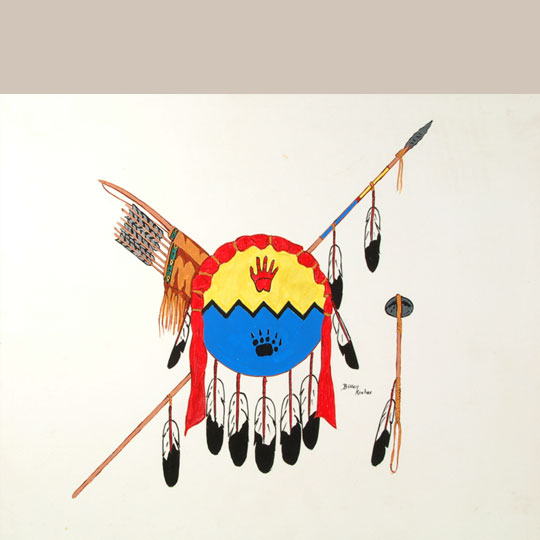 Native Americans valued shields as means of protection. There were two types of shields. One type was used as a defensive tool, to protect against arrows in battle. It was made of thick hide and decorated with symbols of protection that were personal to the owner.
Native Americans valued shields as means of protection. There were two types of shields. One type was used as a defensive tool, to protect against arrows in battle. It was made of thick hide and decorated with symbols of protection that were personal to the owner.
The other type of shield was a medicine shield, made to protect the owner spiritually. It also would be decorated with symbols meaningful to the owner.
This painting is most probably of a warrior shield because of the addition of other symbols of battle. The lance, bow and arrows, and war club are all battle weapons.
Watercolor Painting of a Native American Church Teepee by Billey Kochee - C3556D
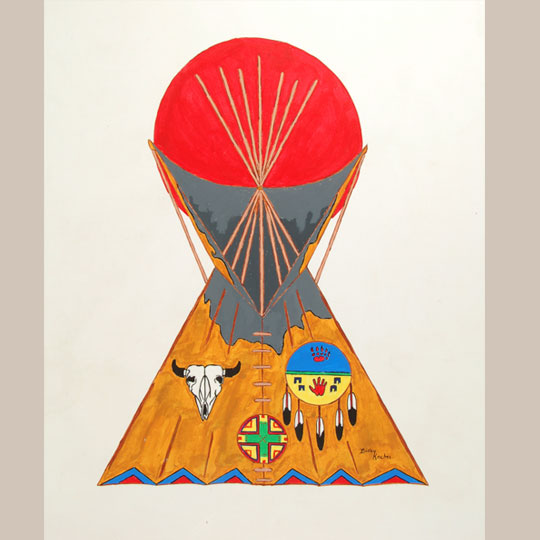 This painting by Billey Kochee contains an assortment of symbols important to Native Americans.
This painting by Billey Kochee contains an assortment of symbols important to Native Americans.
The teepee with a background of poles is an insignia of the Native American Church, or Peyote Religion. The Native American Church, and the use of peyote as a means of achieving a trance, began in Pre-Columbian Mexico and spread to the Great Plains in the late 19th Century.
The buffalo skull symbol is frequently seen on shields of the Plains Indians. The buffalo stands for all that is important to the people. It is a reminder to be grateful for the gifts that are given by the creator.
Historic Tesuque Pueblo Polychrome Pitcher - 25734
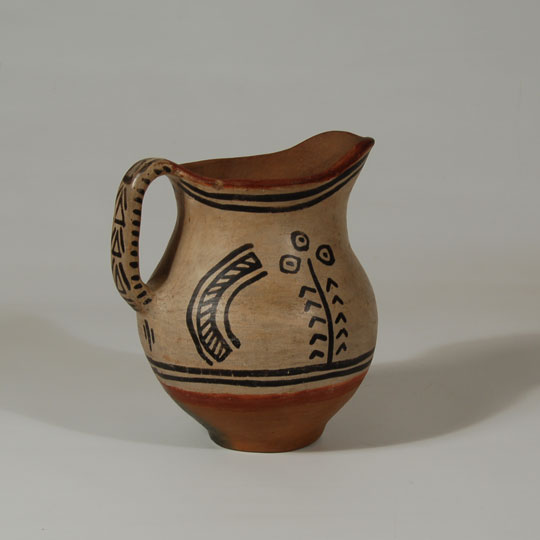 Tesuque Pueblo, Village of the Narrow Cottonwood Trees, is just north of Santa Fe. Its proximity to Santa Fe allowed potters to sell their work to merchants in Santa Fe who, in turn, sold to tourists visiting the southwest. The items made for tourist sale were made to appeal to the visitors and their ability to transport them back home, hence, the forms and sizes changed from the larger utilitarian ollas and bowls made for personal use to small pitchers, vases and jars for the collector to take back home as souvenirs of Indian Country.
Tesuque Pueblo, Village of the Narrow Cottonwood Trees, is just north of Santa Fe. Its proximity to Santa Fe allowed potters to sell their work to merchants in Santa Fe who, in turn, sold to tourists visiting the southwest. The items made for tourist sale were made to appeal to the visitors and their ability to transport them back home, hence, the forms and sizes changed from the larger utilitarian ollas and bowls made for personal use to small pitchers, vases and jars for the collector to take back home as souvenirs of Indian Country.
Cochiti Pueblo Multi-colored Painted Drum - 25896
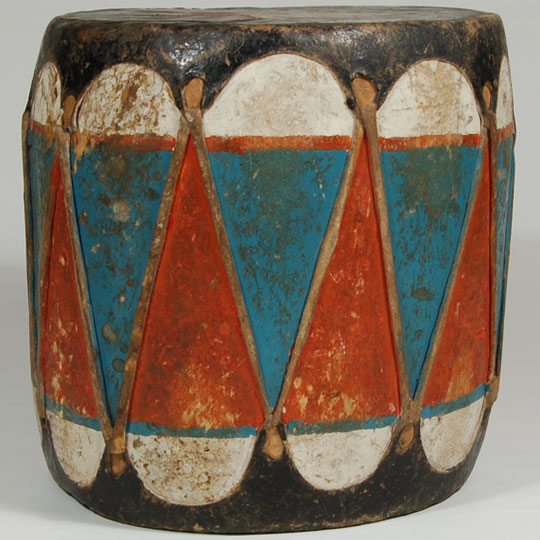 Painted and unpainted drums of all sizes are used in pueblo ceremonies. The drum suggests the thunder that comes with rain. The drum has two heads. Pueblo songs are written to start slowly and then go to a climax. At a certain point of the song, the drum is flipped over to achieve a higher beat. This lifts the dancers and gives them the impetus to continue dancing.
Painted and unpainted drums of all sizes are used in pueblo ceremonies. The drum suggests the thunder that comes with rain. The drum has two heads. Pueblo songs are written to start slowly and then go to a climax. At a certain point of the song, the drum is flipped over to achieve a higher beat. This lifts the dancers and gives them the impetus to continue dancing.
This drum is typical of Cochiti Pueblo drums. The wall is painted with red and blue triangles with their ends painted white.
Hopi Second Mesa Flared Rim Pictorial Basket - 25897
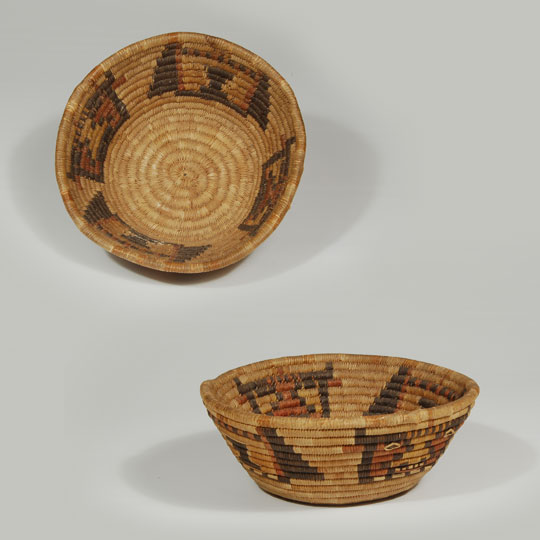 The Hopi Pueblo women of Second Mesa villages have been making coiled basketry for over a thousand years using the same materials and same techniques. None of the materials are from domesticated sources. They all are from wild plants. The leaf of the yucca plant is used for the weft design and grasses are bundled together for the warp foundation. The colors are limited to white, yellow, green, red and black. The first three colors are derived from the yucca leaves, the difference being in the time of year the material is collected. The rust and black colors are dyed yucca leaves.
The Hopi Pueblo women of Second Mesa villages have been making coiled basketry for over a thousand years using the same materials and same techniques. None of the materials are from domesticated sources. They all are from wild plants. The leaf of the yucca plant is used for the weft design and grasses are bundled together for the warp foundation. The colors are limited to white, yellow, green, red and black. The first three colors are derived from the yucca leaves, the difference being in the time of year the material is collected. The rust and black colors are dyed yucca leaves.
Hopi-Tewa Tall Cylindrical Jar by Jacob Koopee (Jake Nampeyo) - C3822
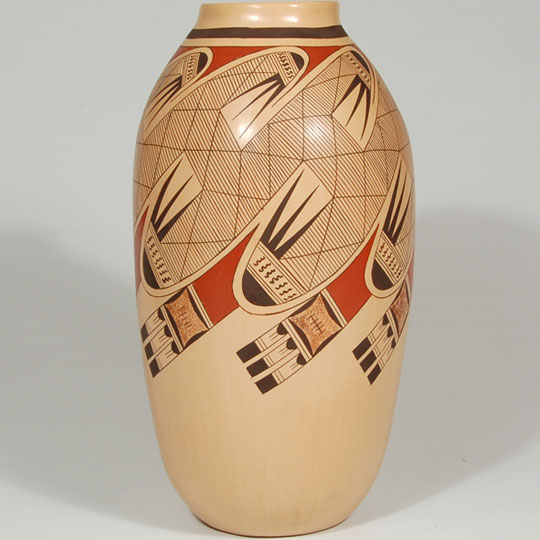 Early in his career, Jacob Koopee made traditional Hopi-Tewa pottery with traditional Nampeyo family design patterns. At that time, in the mid-1990s, he signed his pottery Jake Nampeyo. Later, he made traditional pottery vessel shapes but modernized the designs to those related to the Sikyatki-revival designs. He signed the later pieces Koopee.
Early in his career, Jacob Koopee made traditional Hopi-Tewa pottery with traditional Nampeyo family design patterns. At that time, in the mid-1990s, he signed his pottery Jake Nampeyo. Later, he made traditional pottery vessel shapes but modernized the designs to those related to the Sikyatki-revival designs. He signed the later pieces Koopee.
This cylindrical jar is most certainly a traditional Hopi shape. Hopi-Tewa potters have made cylindrical vessels for over a hundred years. Koopee also applied a very traditional Sikyatki-revival migration pattern to the jar.
Hopi Pueblo Older Mastop Katsina Doll - C3821B
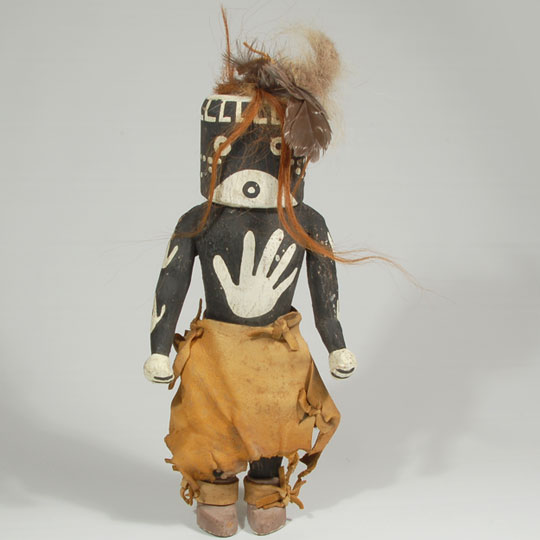 "The Mastop Kachina is the second kachina to appear on Third Mesa. He is not present on Second or First Mesa. These kachinas always arrive in pairs and come bounding out of the northwest on the next to last day of the Soyal. As they rush into the village they beat all the dogs that they encounter using the short black and white staff which they carry for that purpose.
"The Mastop Kachina is the second kachina to appear on Third Mesa. He is not present on Second or First Mesa. These kachinas always arrive in pairs and come bounding out of the northwest on the next to last day of the Soyal. As they rush into the village they beat all the dogs that they encounter using the short black and white staff which they carry for that purpose.
"Leaping about with many antic gestures, they make their way to the Chief Kiva where they talk in disguised voices with the individuals inside and with each other. Then, as though suddenly becoming aware of the females in the audience, they dash madly into a cluster of women and grab their shoulders from behind and they give a series of small hops indicating copulation. Then they return to the kiva and converse for a while before again dashing over to another group of women, repeating the action until nearly every woman present from child to the very oldest has been approached. All women, even the shy ones, do not avoid this embrace as it is a serious fertility rite despite the antic touches, which are never directed towards the women."
Historic Laguna Pueblo Shallow Bowl Dated 1911 - 25717
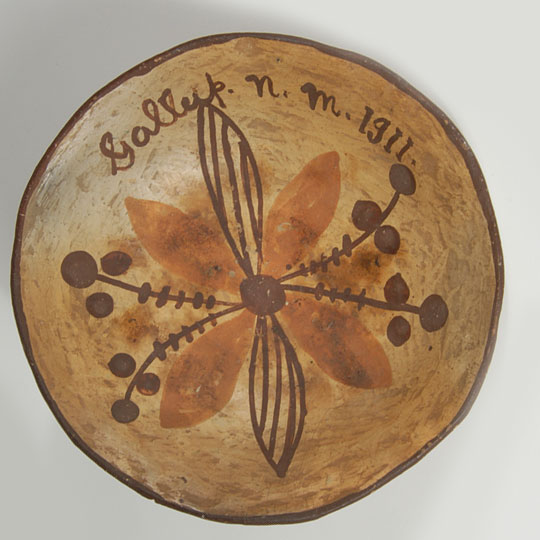 Laguna and Acoma Pueblos are relatively close to Gallup, New Mexico, and potters from those villages have always participated in the Gallup Inter-tribal Indian Ceremonial's arts and crafts fair held annually in August.
Laguna and Acoma Pueblos are relatively close to Gallup, New Mexico, and potters from those villages have always participated in the Gallup Inter-tribal Indian Ceremonial's arts and crafts fair held annually in August.
It is quite likely that a Laguna potter decided to increase her chances of a sale at the Ceremonial by making her dish a Gallup souvenir of that's year's event. It is amazing that this dish has survived without any damage for over a hundred years.
Hopi Pueblo Crow Mother Katsina Doll by Quanhoyeoma - C3821C
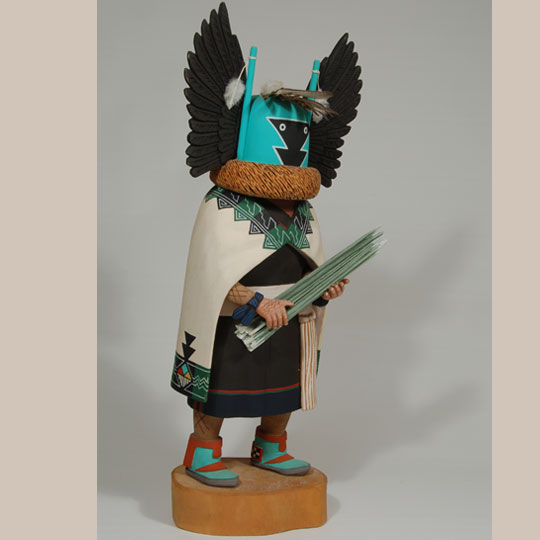 The Hopi consider Angwus-hahai-ie (Crow Mother) to be a Katsina Mother. She is also known as Angwusnasomtaqa, described as Crow Bride. She is presented as a stately personage, moving slowly and singing quietly. It is she who initiates the young boys into the Katsina beliefs and culture. In this function, she is more forceful so as to gain the attention of the boys and deliver her message of the importance of the Katsina culture.
The Hopi consider Angwus-hahai-ie (Crow Mother) to be a Katsina Mother. She is also known as Angwusnasomtaqa, described as Crow Bride. She is presented as a stately personage, moving slowly and singing quietly. It is she who initiates the young boys into the Katsina beliefs and culture. In this function, she is more forceful so as to gain the attention of the boys and deliver her message of the importance of the Katsina culture.
Untitled Painting “In The Shade of the Tree” by Francis Livingston - 25686
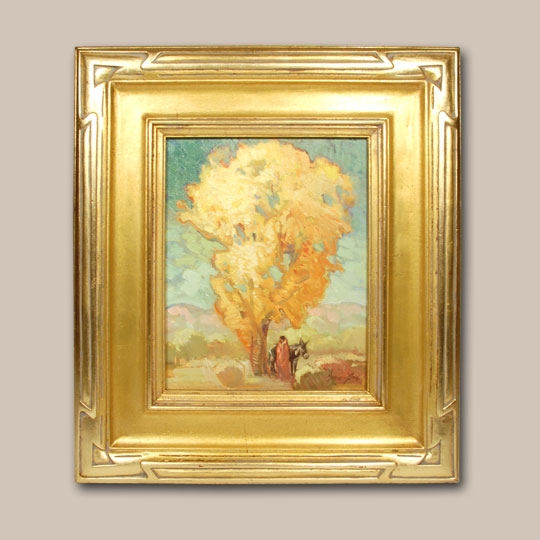 A Taos Pueblo Indian, blanketed in colorful splendor, enjoying a moment of shade, evokes for the viewer what it must have been like to live at Taos Pueblo a couple hundred years ago before the intrusion of the hustle and bustle of the newcomers.
A Taos Pueblo Indian, blanketed in colorful splendor, enjoying a moment of shade, evokes for the viewer what it must have been like to live at Taos Pueblo a couple hundred years ago before the intrusion of the hustle and bustle of the newcomers.
The magnificent manner in which the artist filled the canvas with a colorful cottonwood tree in its fall splendor, illustrates how small humans are in the overall scale of the land. The fall colors of the tree and hillside and the cleanliness of the land bring to mind the Natives' respect for Mother Nature-something lost in the 20th century's disposable lifestyle.
Tohono O’odham Pottery Human Effigy Figurine Bank by Consuelo Julio - C3251J
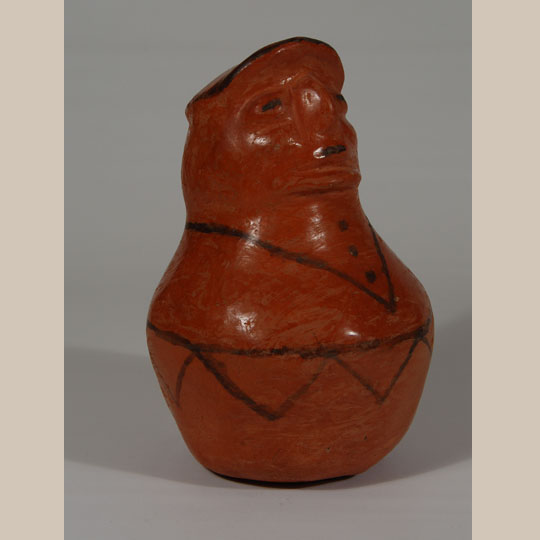 Pottery making by the Tohono O'odham women is a part-time effort as there is no significant market for it as there is for New Mexico pueblo pottery. Part of the reason is that the few potters mostly do not speak English but only speak their native language. Another reason is that most potters do not seek out buyers but wait for buyers to find them.
Pottery making by the Tohono O'odham women is a part-time effort as there is no significant market for it as there is for New Mexico pueblo pottery. Part of the reason is that the few potters mostly do not speak English but only speak their native language. Another reason is that most potters do not seek out buyers but wait for buyers to find them.
Effigy vessels, such as this, particularly ones made with a slot for deposits of coins, were made for sale to non-Indians. The outlets for such wares are the trading posts close to the reservation and the occasional Indian dealer who visits the reservation. Black-on-red wares are not evident in traditional pottery of the tribe before the mid-1800s so it is suspected that it was a style developed to sell to tourists and not for use by the natives.
Oval Deep Apache Basket with Handles - 25810
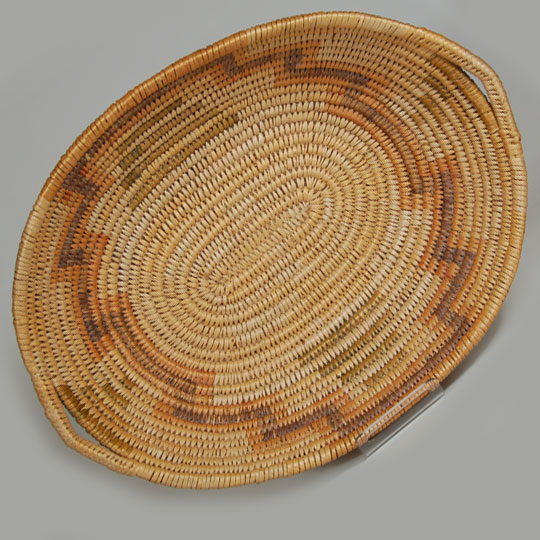 The Jicarilla Apache are known to have had contact with Plains Indians at some point in their history. They made raids on the Plains Indians but always returned to their Mountain home. They went on buffalo hunts and raids for horses and lived in teepees covered with skin or cloth, and they made parfleches like those of the Plains Indians.
The Jicarilla Apache are known to have had contact with Plains Indians at some point in their history. They made raids on the Plains Indians but always returned to their Mountain home. They went on buffalo hunts and raids for horses and lived in teepees covered with skin or cloth, and they made parfleches like those of the Plains Indians.
They also had contacts with Puebloan peoples and is where they learned their agricultural knowledge and possibly learned pueblo basketry techniques. Yet, they were and are Apache and their lifestyle adheres closely with that of Apache tribes.
Painting of Northern New Mexico Mountain Vista by Arthur W. Hall - C3717
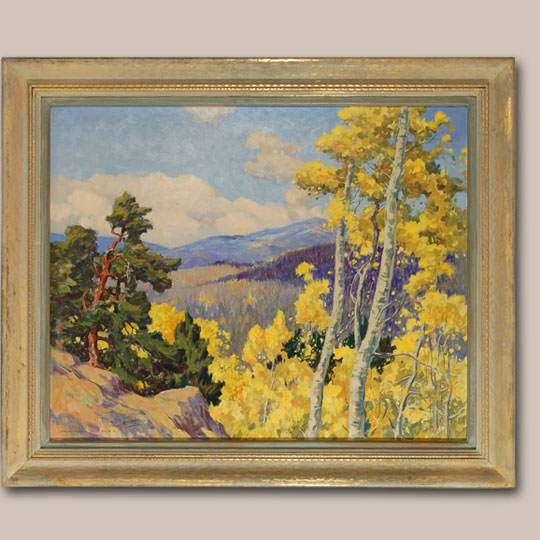 Although Arthur W. Hall specialized in etchings and dry point in his earlier career he was always adept at sketching and painting. He was greatly influenced by years spent in Europe as well as extensive travels in the United States. As an artist he found the scenery and light in Northern New Mexico too good to pass up and in 1942 chose New Mexico as his home. With the exception of a brief period spent in Arizona he would remain here until his passing in 1981.
Although Arthur W. Hall specialized in etchings and dry point in his earlier career he was always adept at sketching and painting. He was greatly influenced by years spent in Europe as well as extensive travels in the United States. As an artist he found the scenery and light in Northern New Mexico too good to pass up and in 1942 chose New Mexico as his home. With the exception of a brief period spent in Arizona he would remain here until his passing in 1981.
Oil on Canvas Painting “Cottonwood Sanctuary” by Tony Abeyta - C3654G
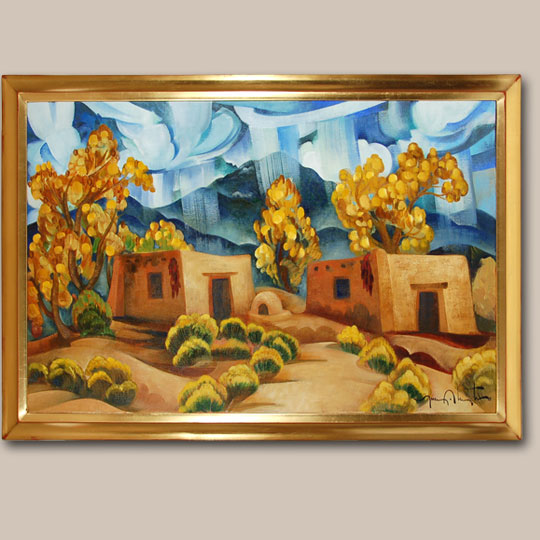 It has been said that Tony Abeyta paints landscapes from his emotional feelings. He does not portray them as actual locations but as an emotional experience one derives from earth meeting sky, color predominating, rain clouds intermingling with blue sky, trees and plants responding to wind and memories returning of past experiences. It is with this emotion that he painted this scene of a pair of small adobe buildings nestled among Chamisa and Cottonwood trees at the base of a mountain with rain falling in copious amounts from beautiful puffy white clouds. It is almost a dream home settlement.
It has been said that Tony Abeyta paints landscapes from his emotional feelings. He does not portray them as actual locations but as an emotional experience one derives from earth meeting sky, color predominating, rain clouds intermingling with blue sky, trees and plants responding to wind and memories returning of past experiences. It is with this emotion that he painted this scene of a pair of small adobe buildings nestled among Chamisa and Cottonwood trees at the base of a mountain with rain falling in copious amounts from beautiful puffy white clouds. It is almost a dream home settlement.

